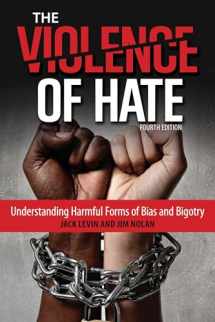
The Violence of Hate: Understanding Harmful Forms of Bias and Bigotry
Book details
Summary
Description
The Violence of Hate, Fourth Edition presents a systematic introduction to issues related to the sociology and social psychology of hate and violence as they target people who are different in socially significant ways. It offers an integrated perspective on the causes and consequences of hate-motivated violence and the reasons we have not always been effective in stopping it. Not only do the authors address the experiences of racial, ethnic, and religious groups under attack, but also those who are victimized because of their sexual orientation, gender, gender-identity, age, or disability status. In addition, they include a chapter dedicated solely to the exploration of hate crimes, an evolving legal concept and public policy domain, as well as a chapter in which they suggest approaches that may be effectively applied collectively to the reduction of hate violence. As in earlier versions of The Violence of Hate, Levin and Nolan take the position that support for hate-motivated violence originates not in the ranting and raving of a few bigoted extremists at the margins of society but in the tacit approval of ordinary, even decent, people who are located squarely in the mainstream.
Updates to the Fourth Edition:
- Chapter 1: New discussions of structural and cultural factors illustrated by the racial conflicts in Ferguson Missouri, New York City, and Baltimore. New presentation of the recent ADL survey indicating degree of bigotry in more than 100 countries. New discussion of how threatening situations inspire increases in hate violence against a range of vulnerable groups.
- Chapter 2: New chapter on hate violence around the world involving the experiences of Roma in Europe, sexual orientation and gender identity violence, and anti-Semitic and anti-Islamic violence in European countries. Includes discussions of violent responses to anti-Mohammed cartoons in Europe and North America, sectarian violence in Northern Ireland and the Middle East, and police versus the black community in the United States.
- Chapter 3: Updated discussion of issues related to reporting hate incidents and collecting hate crime data. Expanded presentation of hate crime laws at the federal and state levels. New discussions of the problems associated with policing hate and the role of social media in spreading hate.
- Chapter 4: New section on mass murder in the name of hate, including the Sikh Temple massacre outside of Milwaukee, the Charleston Black Church massacre, Baumhammer’s killing spree targeting immigrants, Jews, and non-whites in the Pittsburgh area, Taylor’s killing spree targeting whites, and black church burnings in the 1990s and 2015. New discussion of thrill hate crimes against the homeless, people with disabilities, and gays.
Features:
- Uses a single conceptual framework to explore racism in American society, and the historical occurrence of anti-Semitism, with special emphasis on Nazi Germany.
- The experiences of other groups, such as Armenians massacred in 1915 and gay students victimized by violence, are also examined to provide a broad comparative perspective.
- Shows the economic and psychological benefits of hate, making it an expected, even rational, behavior.
- Examines the evolution of hate crime legislation in the United States and the impact of this legislation on the institutions of law and criminal justice.
- Shows how prejudice and hate can be addressed locally, but have an impact globally.
- The final chapter argues that respect for differences requires rebellious and even deviant behavior.


We would LOVE it if you could help us and other readers by reviewing the book
Book review



